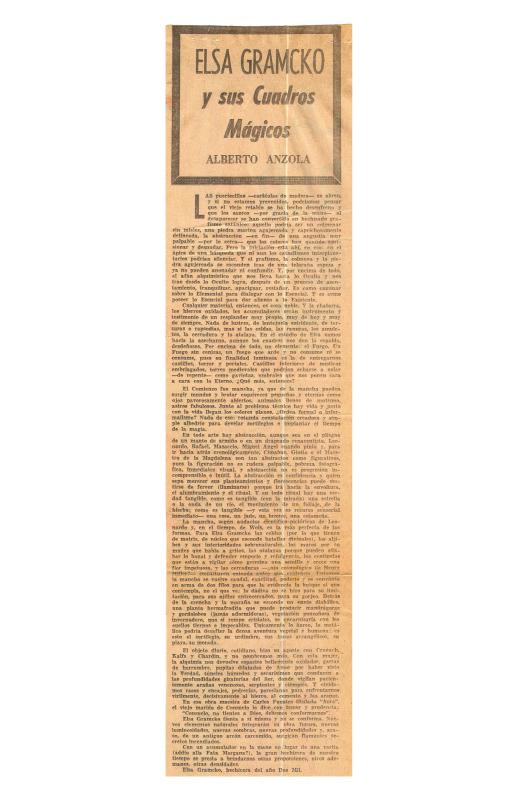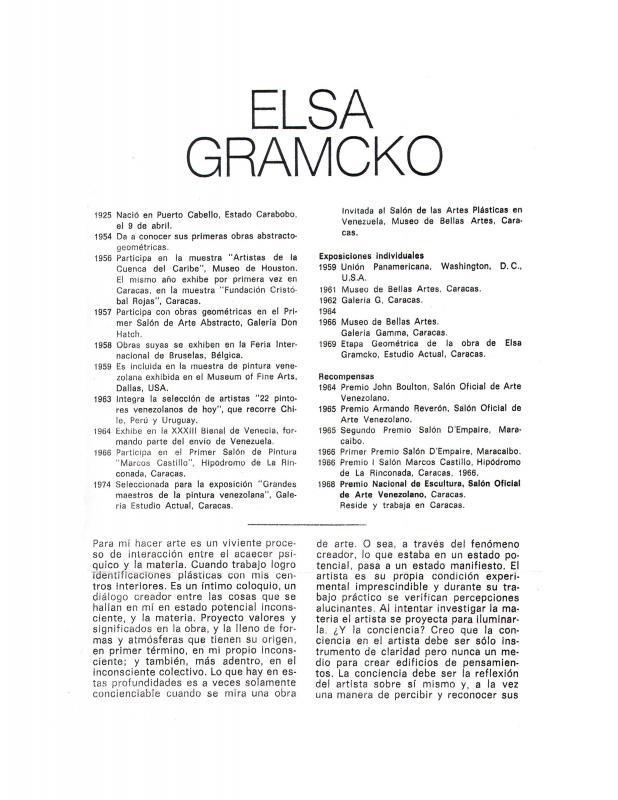Eminent Argentinean-Venezuelan gallerist Clara Diament de Sujo, who ultimately settled in New York, wrote the prologue to the catalogue for the exhibition of work by Elsa Gramcko (1925–1994), held at the Museo de Bellas Artes de Caracas in early 1961. Sujo makes use of an array of literary resources in a prose poem that expresses her admiration for Gramcko’s work. This lyrical text—the first one on Gramcko published in Venezuela—was written for the artist’s second solo show anywhere and her first show in Caracas. It is significant that the first text on Gramcko written in Venezuela was a poem; Gramcko’s painting was bound to poetry due to her interest in literature and the influence of her sister Ida, a poet. Over the course of her artistic career, Gramcko found ways to satisfy her expressive needs until the “material” of her work became her own artistic language. The main topic of this poetic text is the transmutation and creation of matter and form, a concern that runs through Gramcko’s production. Indeed, that is why Gramcko was called “the alchemist” in many later writings (Elizabeth Schön, GAN, 1997, see ICAA digital archive doc. no. 1152629). Because this text was written in the early years of her career, it makes no mention of the artist’s liaison with informalist tendencies.
For other critical essays on and interviews with the artist, see José Gómez Sicre, “Elsa Gramcko of Venezuela” (doc. no. 1222685), published in 1959; Oswaldo Trejo, “Elsa Gramcko” (doc. no. 1153620), published in 1966; Alberto Anzola, “Elsa Gramcko y sus cuadros mágicos” (doc. no. 1153668), published in 1968; eminent critic Roberto Guevara, “Abstractos inéditos de Elsa Gramcko” (doc. no. 1163749), published in El Nacional in 1969; Juan Calzadilla, “Elsa Gramcko: la atracción de las texturas” (doc. no. 1153589), published in 1969; an untitled text published in 1970 (doc. no. 1153636); “Entrevista con Elsa Gramcko” (doc. no. 1152673), published in 1976; Teresa Alvarenga, “Elsa Gramcko por ahora el silencio” (doc. no. 1153652), written in 1979; and the aforementioned essay by Juan Carlos López Quintero, “Elsa Gramcko una alquimista de nuestro tiempo” (doc. no. 1152657), published in 1997.










